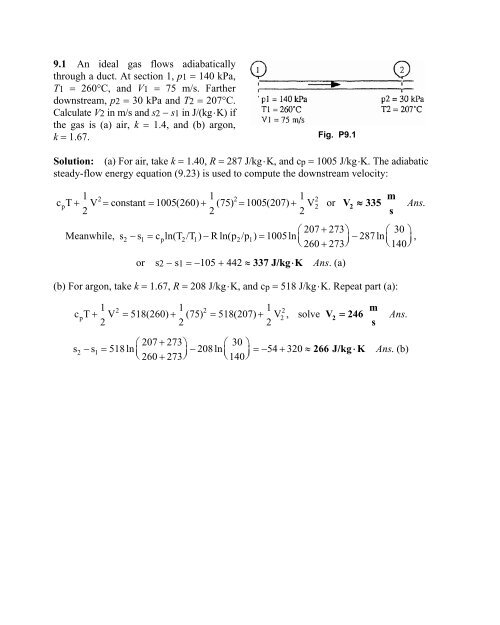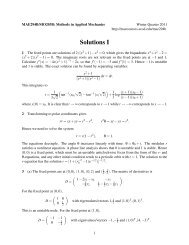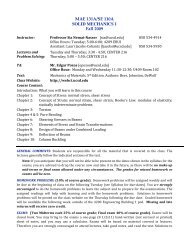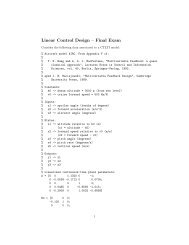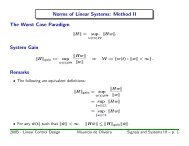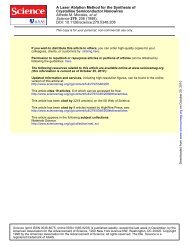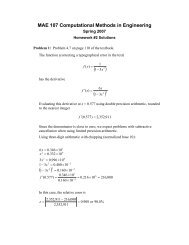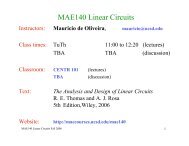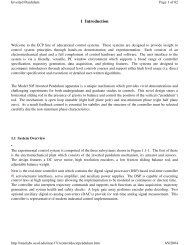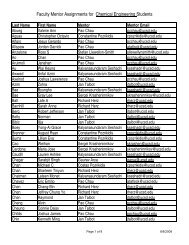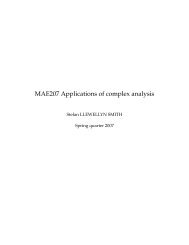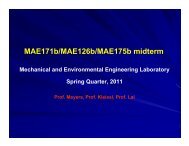9.1 An ideal gas flows adiabatically through a duct. At section 1, p1 ...
9.1 An ideal gas flows adiabatically through a duct. At section 1, p1 ...
9.1 An ideal gas flows adiabatically through a duct. At section 1, p1 ...
Create successful ePaper yourself
Turn your PDF publications into a flip-book with our unique Google optimized e-Paper software.
<strong>9.1</strong> <strong>An</strong> <strong>ideal</strong> <strong>gas</strong> <strong>flows</strong> <strong>adiabatically</strong><br />
<strong>through</strong> a <strong>duct</strong>. <strong>At</strong> <strong>section</strong> 1, <strong>p1</strong> = 140 kPa,<br />
T1 = 260°C, and V1 = 75 m/s. Farther<br />
downstream, p2 = 30 kPa and T2 = 207°C.<br />
Calculate V2 in m/s and s2 − s1 in J/(kg ⋅K)<br />
if<br />
the <strong>gas</strong> is (a) air, k = 1.4, and (b) argon,<br />
k = 1.67.<br />
Fig. P<strong>9.1</strong><br />
Solution: (a) For air, take k = 1.40, R = 287 J/kg ⋅ K, and cp = 1005 J/kg ⋅K. The adiabatic<br />
steady-flow energy equation (9.23) is used to compute the downstream velocity:<br />
1 2 1 2 1 2<br />
m<br />
cpT + V = constant = 1005(260) + (75) = 1005(207) + V2 or V2 ≈ 335 <strong>An</strong>s.<br />
2 2 2<br />
s<br />
⎛207 + 273⎞ ⎛ 30 ⎞<br />
Meanwhile, s2 − s1 = cpln(T 2/T 1) − R ln(p 2/p 1)<br />
= 1005ln ⎜ −287<br />
ln ,<br />
⎝<br />
⎟ ⎜<br />
260 + 273⎠ ⎝<br />
⎟<br />
140⎠<br />
or s2 − s1 = −105 + 442 ≈ 337 J/kg ⋅ K <strong>An</strong>s. (a)<br />
(b) For argon, take k = 1.67, R = 208 J/kg ⋅ K, and cp = 518 J/kg ⋅ K. Repeat part (a):<br />
1 2 1 2 1 2<br />
m<br />
cpT+ V = 518(260) + (75) = 518(207) + V 2,<br />
solve V2 = 246 <strong>An</strong>s.<br />
2 2 2<br />
s<br />
⎛207 + 273⎞ ⎛ 30 ⎞<br />
s2 − s1 = 518 ln ⎜ ⎟ − 208 ln ⎜ ⎟ = − 54 + 320 ≈ 266 J/kg ⋅ K<br />
<strong>An</strong>s.<br />
(b)<br />
⎝260 + 273⎠ ⎝140⎠
P9.7 Air <strong>flows</strong> <strong>through</strong> a variable-area <strong>duct</strong>. <strong>At</strong> <strong>section</strong> 1, A1 = 20 cm 2 , <strong>p1</strong> = 300 kPa, ρ1 =<br />
1.75 kg/m 3 , and V1 = 122.5 m/s. <strong>At</strong> <strong>section</strong> 2, the area is exactly the same, but the density is<br />
much lower: ρ2 = 0.266 kg/m 3 , and T2 = 281 K. There is no transfer of work or heat. Assume<br />
one-dimensional steady flow. (a) How can you reconcile these differences? (b) Find the mass<br />
flow at <strong>section</strong> 2. Calculate (c) V2, (d) p2, and (e) s2 – s1. Hint: This problem requires the<br />
continuity equation.<br />
Solution: Part (a) is too confusing, let’s try (b, c, d, e) first. (b) The mass flow must be<br />
constant:<br />
m�<br />
1<br />
Then<br />
= m�<br />
V<br />
2<br />
2<br />
= ρ A V<br />
=<br />
1<br />
2<br />
1<br />
m�<br />
ρ A<br />
1<br />
2<br />
kg<br />
2 m<br />
= ( 1.<br />
75 )( 0.<br />
0020m<br />
)( 122.<br />
5 )<br />
3<br />
m<br />
s<br />
=<br />
kg<br />
0.<br />
0429<br />
s<br />
=<br />
0.<br />
0429kg<br />
/ s<br />
3<br />
2<br />
( 0.<br />
266kg<br />
/ m )( 0.<br />
002m<br />
)<br />
=<br />
m<br />
806<br />
s<br />
<strong>An</strong>s.(<br />
c)<br />
1/2 1/2<br />
<strong>An</strong>s.(<br />
b)<br />
That’s pretty fast! Check a 2 = (kRT 2) = [1.4(287)(281)] = 336 m/s. Hence the Mach<br />
number at <strong>section</strong> 2 is Ma 2 = V2/a2 = 806/336 = 2.40. The flow at <strong>section</strong> 2 is supersonic!<br />
(d) The pressure at <strong>section</strong> 2 is easy, since the density and temperature are given:<br />
p<br />
2<br />
= ρ RT<br />
2<br />
Similarly,<br />
T<br />
2<br />
1<br />
= ( 0.<br />
266kg<br />
/ m )( 287 m / s − K)(<br />
281K<br />
) = 21,<br />
450 Pa<br />
=<br />
<strong>p1</strong><br />
Rρ<br />
=<br />
( 300000 Pa)<br />
2<br />
3<br />
( 287 m / s − K)(<br />
1.<br />
75kg<br />
/ m )<br />
= 597 K<br />
1<br />
3<br />
2<br />
2<br />
2<br />
<strong>An</strong>s(<br />
d)<br />
(e) Finally, with pressures and temperatures known, the entropy change follows from Eq. (9.8):<br />
T2<br />
p2<br />
281 21450<br />
J<br />
s2 − s1<br />
= c p ln( ) − R ln( ) = 1005ln(<br />
) − 287 ln( ) = − 757 + 757 ≈ 0<br />
T p<br />
597 300000<br />
kg − K<br />
1<br />
1<br />
Ahah! Now I get it. (a) The flow is isentropic. <strong>An</strong>s.(a) The stagnation properties, T = 605 K,<br />
o<br />
3<br />
p o = 319 kPa, and ρ o = 1.805 kg/m are constant in the flow from <strong>section</strong> 1 to <strong>section</strong> 2.<br />
<strong>An</strong>s.(<br />
e)
9.8 <strong>At</strong>mospheric air at 20°C enters and<br />
fills an insulated tank which is initially<br />
evacuated. Using a control-volume analysis<br />
from Eq. (3.63), compute the tank air<br />
temperature when it is full.<br />
Solution: The energy equation during filling of the adiabatic tank is<br />
dQ dWshaft dECV<br />
+ = 0 + 0 = −hatmm � entering,<br />
or, after filling,<br />
dt dt dt<br />
ECV,final − ECV,initial = hatmm entered, or: mcvTtank = mcpT<br />
atm<br />
Thus T = (c /c )T = (1.4)(20 + 273) ≈ 410 K = 137° C <strong>An</strong>s.<br />
tank<br />
p v atm


